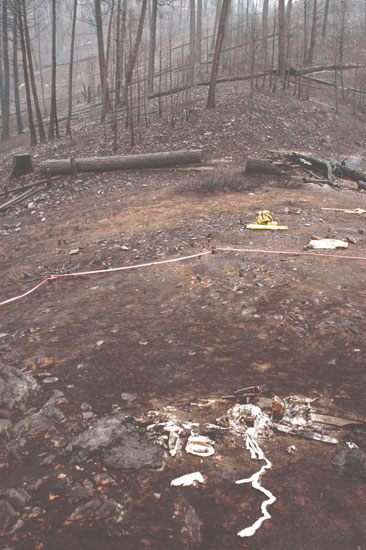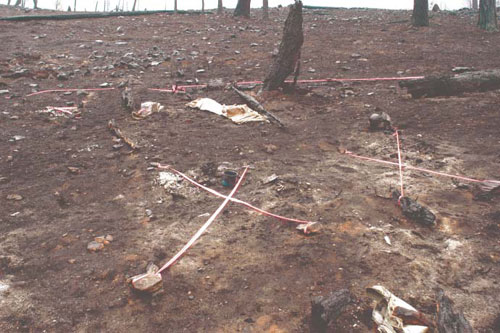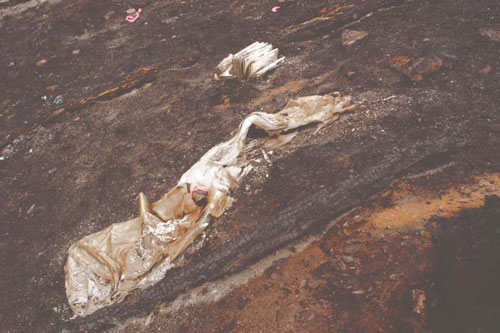
Lessons Learned
“Safety
Zone” newsletter, July, 2004
Lessons Learned —
author, date unknown
One-Year Anniversary Letter
by Kelly Close, FBAN
Declaration on Cramer
Redactions, by James Furnish, April, 2005
FSEEE v. USFS, FOIA
Civil Lawsuit Order,
December, 2005
FOIA
Request to USFS, December, 2005
FOIA Appeal to USFS,
February, 2006
Management Evaluation Report
Investigation Team Information
Synopsis of the
Cramer Fire Accident Investigation
Causal Factors
Contributing Factors
Addendum
Factual Report
Executive Summary
Narrative
Background
(facts 1 - 57)
Preaccident
(facts 58 - 201)
Accident
(fact 202)
Postaccident
(facts 203 - 237)
Findings
Appendix A
Resources on the Fire
Appendix B
Cramer Fire Timeline
Appendix C
Fire Behavior and Weather
Prior Conditions
Initial Phase
Transition
Phase
Acceleration
Phase
Entrapment
Phase
Appendix D
Equipment Found at H-2 and the Fatalities Site
Appendix E
Fire Policy, Directives, and Guides
OIG Investigation
OIG FOIA Response,
February, 2005
2nd FOIA Request to OIG,
April, 2006
2nd OIG FOIA Response,
August, 2006, (1.4 mb, Adobe .pdf file)
OSHA Investigation
OSHA Cramer Fire Briefing Paper
• Summary and ToC
• Sections I-IV
• Sections V-VII
• Section VIII
• Acronyms/Glossary
OSHA South Canyon Fire
Briefing Paper
Letter to District
Ranger, June 19, 2003
OSHA Investigation Guidelines
OSHA News Release
• OSHA Citation 1
• OSHA Citation
2
• OSHA
Citation 3
USFS Response
OSHA FOIA Letter
Adobe PDF and Microsoft Word versions of documents related to
the Cramer Fire can be downloaded from the U.S.
Forest Service website.
|
Accident Investigation
Factual Report
Cramer Fire Fatalities
North Fork Ranger District
Salmon-Challis National Forest
Region 4
Salmon, Idaho - July 22, 2003
Appendix D—Equipment Found at H-2 and the Fatalities Site
Equipment used by Jeff Allen and Shane Heath for rappelling from H-193
to the ground and for construction of the helispot was found at H-2. The
equipment had been readied for transport. One of the saws had been wrapped
with chain saw chaps, the hand tools had been wrapped in fiberglass tape,
and all of the equipment was stacked in a single pile.

Photo 1—H-2, chain saws, and rappel equipment.
Though severely damaged by fire, the stack appears to have contained
helicopter rappel equipment, a radio, three hand tools, and two chain
saws with associated maintenance tools. Only steel, glass, brass, and
some aluminum were still intact. The rest of the material was either consumed
or melted by the fire. Some pieces of cast aluminum melted, indicating
material temperatures of at least 1,000 ºF (photos 1 and 2).

Photo 2—H-2, chain saws, rappel equipment, and melted aluminum.
The remains of two fire shelters, personal items such as watches, cameras,
keys, and belt buckles, and work-related items, including a radio, carabiners,
and batteries were found at the fatalities site. Only steel, glass, and
brass items were intact. The glass watch face was distorted as if it had
softened. Glass begins to soften when it reaches about 1,100 ºF. Two flight
helmets on the site were charred, easily compressed, and brittle (photo
3).

Photo 3—Fatalities site, fire shelters, and flight helmets.
The fire shelters were the older style (NSN# 4240-01-121-8698, NFES#
0169), which meet agency requirements (photo 4). The shelters were separate
from other materials, which indicates they had been removed from their
packs. One of the shelters was accordion folded in the same shape in which
it was packaged, indicating that it had not been unfolded prior to the
burnover. The exposed top layers of the folded shelter had no remaining
foil and the fiberglass layer was white and very fragile. Where foil was
present on the more protected layers, it was completely delaminated from
the fiberglass cloth. Aluminum used in the shelters melts at about 1,200
ºF. The fiberglass used in the shelters softens between 1,350 and 1,611
ºF. The condition of the exposed fiberglass indicates that material temperatures
were within this range.

Photo 4—Fatalities site where fire shelters were not deployed.
The second fire shelter was unfolded lengthwise but almost completely
folded width-wise. This indicates that the shelter was removed from its
plastic bag and partially unfolded prior to the burnover. The foil had
melted from 10 of the 12 layers of the shelter and was present on the
two layers that lay closest to the ground. Foil that remained had completely
delaminated from the fiberglass layer. The fiberglass cloth was white
and extremely brittle, indicating that it had reached a softening temperature
between 1,350 and 1,611 ºF.
Crown fires studied with instruments by MTDC have reached temperatures
over 2,000 ºF. Temperatures from approximately 1,300 ºF have damaged fire
shelters, melting aluminum, and fracturing and disintegrating fiberglass
cloth. Conditions inside fire shelters tested in these conditions were
not survivable. The condition of the partially unfolded fire shelter found
at the fatalities site resembled fire shelters tested under these severe
conditions. This indicates that the shelter was subjected to temperatures
from 1,300 ºF to potentially over 2,000 ºF.
<<< continue
reading—Appendix E>>>
|
